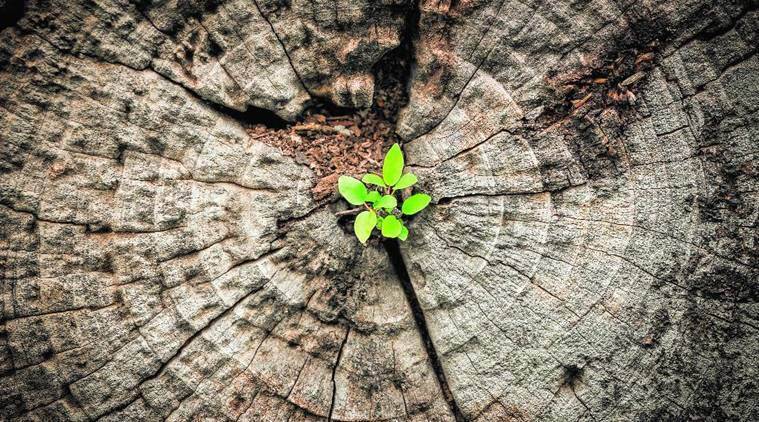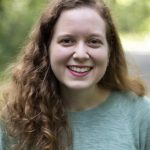Advent: Encountering strongholds of fear, preparing for the ‘thrill of hope’

"When we don't abandon ourselves to fear, nor abandon the places of fear within us," writes Lindsey Weishar, "we offer ourselves the opportunity to discover threads of new grass wending through charred soil, the sprout of a new tree growing up out of the remnants of a shattered one."
By Lindsey Weishar / “My Vocation is Love”
There is something beautifully hidden about the season of Advent. The early darkness of the evenings and the cooling weather invite us to spend time on the inside — in our homes, with ourselves.
If it wasn’t 2020, I’d probably be looking forward to this season more. But as it is, life in the midst of pandemic has been hard enough before the darkness, before the cold, before rising rates of illness and increased isolation. The last place I want to be is with myself.
My guess is that for many of us fear has been a greater part of our realities this year. In my own interior life, fear’s effect feels like the aftermath of a forest fire. In the desolation left by fear, I struggle to perceive God or others, cannot imagine even a glimmer of hope ever meeting me here. As I’ve watched fear, anxiety, and hopelessness increase in the world this year, I’ve come to realize that untended fear doesn’t just disappear with time.
So, what to do with fear? I’ve found that the answer is neither to abandon myself to fear, nor to abandon my fear to distractions. I’m called to stay with my fear so I can better understand it, and then to ask trusted others to accompany me through it. Though this act of inviting others into my fear is difficult, being known and loved in my woundedness carves pathways for healing.
TENDING TO OUR INNER WORLD
In 2010 my family visited Mount St. Helens in Washington state. In a nearby museum, we learned that the volcano had erupted in 1980, razing the landscape, killing people, and destroying everything in its path. While we walked along the trails, we saw tall trees, the deep green of leaves, wildflowers — a landscape greatly transformed from its old devastation.
The landscape of Mount St. Helens reminds me that the wounded places within us, those places where fear congregates, are the places that can most teach us about beauty, about light. When we don’t abandon ourselves to fear, nor abandon the places of fear within us, we offer ourselves the opportunity to discover threads of new grass wending through charred soil, the sprout of a new tree growing up out of the remnants of a shattered one.
A spiritual writer who taught me much about encountering God and myself in my own interior landscape is Holocaust victim Etty Hillesum. Etty lived in the Netherlands and was killed at age 29. During the last couple years of her life, she experienced an “awakening” to the necessity of attending to her inner world. For her this space was vast: “My inner landscape consists of great, wide plains, infinitely wide, with hardly a horizon in sight.”
As the Nazis drew nearer to her country, the security of Etty’s outer world diminished. In her writings (collected in “An Interrupted Life” and “Etty Hillesum: Essential Writings”), she notes her own and others’ responses to the growing fear — bitterness, hatred, terror, and a desire for self-preservation. In the midst of escalating chaos, Etty finds within herself a safe place she can go to experience security and God’s love.
From Etty, I’ve learned the beauty of tending to the inner world, of staying with myself in the places of struggle. For Etty, this practice led to peace. In one entry she says, “The jasmine behind my house has been completely ruined by the rains and storms of the last few days. . . . But somewhere inside me the jasmine continues to blossom undisturbed, just as profusely and delicately as ever it did.” The place within becomes a reservoir from which Etty draws strength to love others, even as fear increases in the world around her.
A REBIRTH OF CHRIST IN OURSELVES
Advent prepares us to encounter the “thrill of hope,” that is the birth of a Savior in the dark of night. Perhaps we’ve never more needed this hope, this rebirth of Christ in ourselves. If you find yourself contending with strongholds of fear in this small, hidden season, my prayer is that the return to the desolate places reveals wildflowers. The simplest turning of our wills toward him — in the receiving of Holy Communion, in saying “Help me, Lord” in the midst of interior darkness –seeds those seemingly barren spaces.
A dear person once told me God is sometimes like the sun behind the clouds, present even if undiscernible. He’s there in the darkness, and he wants even these places for himself. In encountering our fears, we invite Christ in whom “The hopes and fears of all the years” are not only met but illuminated by his love.
Lindsey Weishar is a freelance writer and member of St. Matthew Parish in Champaign. She has a master of fine arts degree in creative writing from the University of Missouri, Kansas City. Write to Lindsey at lweisharwriting@gmail.com.






